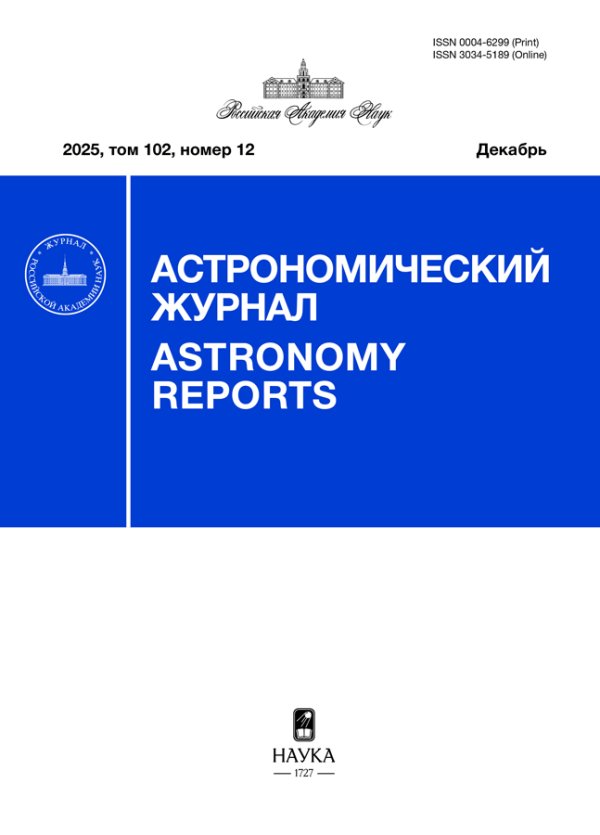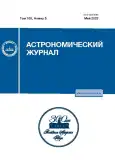Vol 100, No 5 (2023)
Articles
The Structure of the Universe in the Quasar Absorption Spectra
Abstract
An analysis of the absorption lines observed in the spectra of quasars makes it possible to study the evolution of the structure of the Universe up to redshifts z∼5. The observed clustering of C IV lines demonstrates the multiple birth of low-mass galaxies in separate structural elements—filaments and “pancakes.” This ensures their subsequent regular hierarchical merger in the central galaxy or group of galaxies. Remnants of the early “pancakes” are observed today as the Local Group, groups around the Andromeda and Centaurus galaxies, and other small groups of galaxies. In turn, the observed clustering of Lyman-alpha lines shows that starless dark matter (DM) halos are also formed in structural elements and their hierarchical clustering leads to the formation of massive starless dark matter halos of moderate density, which also appear in numerical models.
 395-403
395-403


Dependences of Characteristics of Bulges on the Mass of the Central Black Hole and Theoretical Aspects of Their Origin
Abstract
To study the influence of the central black hole on the formation of the bulge of spiral galaxies, we analyzed the relationship between the masses of supermassive black holes (SMBHs) and the parameters of their bulges. Unlike other authors, we consider only spiral galaxies. In this paper, we present empirical formulas derived from observations of 54 spiral galaxies, establishing connections between the mass of the central black hole (MBH), the bulge stellar mass (Mbulge), and the velocity dispersion (σ) of stars in it. A non-linear non-stationary disk model with an anisotropic velocity diagram is constructed. Within this model, the instabilities of individual perturbation modes are studied. The increments of instability are calculated depending on the physical parameters of the model. These values are compared across three perturbation modes. The paper is partly based on the report presented at the conference “Modern Stellar Astronomy-2022,” held at the Caucasian Mountain Observatory of the Sternberg Astronomical Institute of Lomonosov Moscow State University, on November 8–10, 2022.
 404-413
404-413


Regular Chains of Star Formation Regions in Spiral Arms and Rings of Disk Galaxies
Abstract
The regularity in the distribution of young stellar groups along the spiral arms of galaxies, first discovered by Bruce and Debra Elmegreen in 1983, was considered a rather rare phenomenon. However, recent studies of the spatial regularities in the distribution of the young stellar populations along the arms of the spiral galaxies NGC 628, NGC 895, NGC 4321, NGC 5474, NGC 6946, as well as along the rings of the spiral galaxy NGC 6217 and the lenticular galaxy NGC 4324, have revealed that this spatial (quasi) regularity and/or the presence of regular chains of star-forming regions is a fairly common phenomenon. Across all galaxies, the characteristic regularity scale is 350–500 pc or a multiple thereof. It should be noted that theoretical models predict an instability scale of a stellar-gas disk on the order of a few kpc, which is several times larger than what has been observed. The paper is partly based on the report presented at the Modern Stellar Astronomy 2022 Conference held at the Caucasian Mountain Observatory of the Sternberg Astronomical Institute, Moscow State University, on November 8–10, 2022.
 414-426
414-426


Effect of Dust Evaporation and Thermal Instability on Temperature Distribution in a Protoplanetary Disk
Abstract
The thermal instability of accretion disks is widely used to explain the activity of cataclysmic variables, but its manifestation in gas and dust disks in young stars has been studied in less detail. A semi-analytical stationary model is presented for calculating the equatorial temperature of a gas and dust disk around a young star. The model considers the opacity caused by dust and gas, as well as the evaporation of dust at temperatures above 1000 K. Using this model, the distributions of the equatorial temperature of the gas and dust disk are calculated under various assumptions on the source of opacity and the presence of dust. It is shown that when all the above processes are considered, the thermal balance equation in the region r<1 AU has multiple temperature solutions. Thus, the conditions for thermal instability are satisfied in this region. As an illustration of the possible influence of instability on the nature of accretion in a protoplanetary disk, we consider a viscous disk model with α-parametrization of turbulent viscosity. It is shown that in such a model a non-stationary mode of disk evolution is realized with alternating phases of accumulation of matter in the inner disk and phases of its rapid accretion onto the star, which leads to a burst character of accretion. The results obtained indicate the need to take this instability into account when modeling the evolution of protoplanetary disks.
 427-440
427-440


The Exo-Jupiter Candidate FL Lyr b in Data of Kepler and TESS Space Missions
Abstract
We study the light-time effect in the eclipsing binary system FL Lyr using data of the Kepler and TESS space missions. We demonstrate that the system contains a candidate exo-Jupiter FL Lyr b, its probable orbital period being about 22 years.
 441-451
441-451


Dynamic Study of the Triple Star T Tauri
Abstract
The triple system of young stars T Tauri was discovered relatively recently and has attracted the attention of numerous researchers. Many papers have been dedicated to the study of the physical properties of the system’s stars, which are surrounded by a disk of dust and gas. Our work is focused on the astrometric analysis of this triple system using the method of apparent motion parameters (AMP). Currently, the orbit of the inner pair Sa-Sb with a period of 27 years is well-established. Based on the Gaia DR3 parallax, its total mass MSa + Sb=2.49M⊙. Relying on the published high-precision uniform observations with the Keck 1 and VLT telescopes, we employed the AMP method to derive two orbits for the outer pair N-S, one of which is almost circular. For a circular orbit, it is possible to calculate the orbital elements and dynamic parallax for a given mass solely using the apparent motion parameters. This enabled a comparison between the dynamic parallax and the high-precision parallax from the Gaia DR3 catalog, facilitating the calculation of masses of each component based on the mass of the inner subsystem: MN=(2.4±0.2)M⊙, MSa=(2.09±0.05)M⊙, MSb=(0.40±0.05)M⊙. The boundaries for the orbital period were estimated to be 500⩽P⩽700 years.
 452-460
452-460


Comparison of Instabilities of Annular Perturbations on the Background of Pulsating 2D and 3D Self-Gravitating Models
Abstract
The problem of gravitational instability of the observed annular (ring-like) structural perturbation modes on the background of a nonlinearly pulsating spherical model based on the well-known equilibrium Camm ball is studied. Nonstationary analogues of dispersion relations for the perturbation modes under consideration within this model are obtained. Critical diagrams of the initial virial ratio versus the model rotation parameter are constructed for each case. A comparative analysis of the increments of gravitational instability of annular perturbation modes on the background of spherical and disk-shaped nonlinearly pulsating models is also performed. An analysis of the results shows that the annular perturbation modes are predominantly more unstable in a nonstationary disk than in a spherical nonequilibrium model, regardless of the rotation parameters and the initial virial ratio of the systems. The article is partly based on a report presented at the conference “Modern Stellar Astronomy-2022” held at the Caucasian Mountain Observatory of the Sternberg Astronomical Institute of Lomonosov Moscow State University, November 8–10, 2022.
 461-471
461-471


Adiabatic Radio Emission Spectrum of the Sun’s Coronal Holes
Abstract
Coronal holes on the Sun have been observed at individual frequencies for quite a long time in the wavelength range from radio to X-rays. Observations in a wide range of radio frequencies are carried out with the RATAN-600 radio telescope. An analysis of long-term spectral observations of the RATAN-600 radio telescope showed that the emission spectrum of coronal holes is radically different from the spectrum of active formations above sunspots, but, differing markedly from the spectrum of the quiet Sun, it also has similarities with it. It has been established that the radio emission of coronal holes has an adiabatic spectrum and does not contain noticeable coherent radiation, that is, recombination radio lines and lines of the fine structure of hydrogen and other elements.
 472-478
472-478












